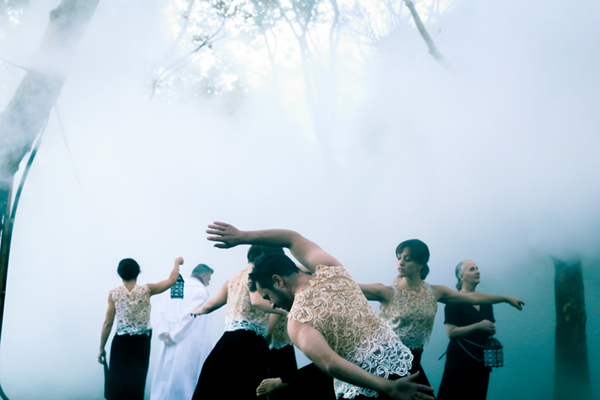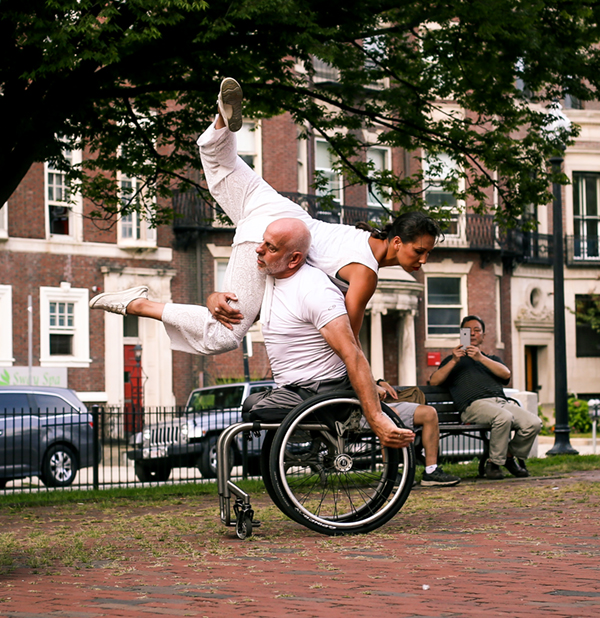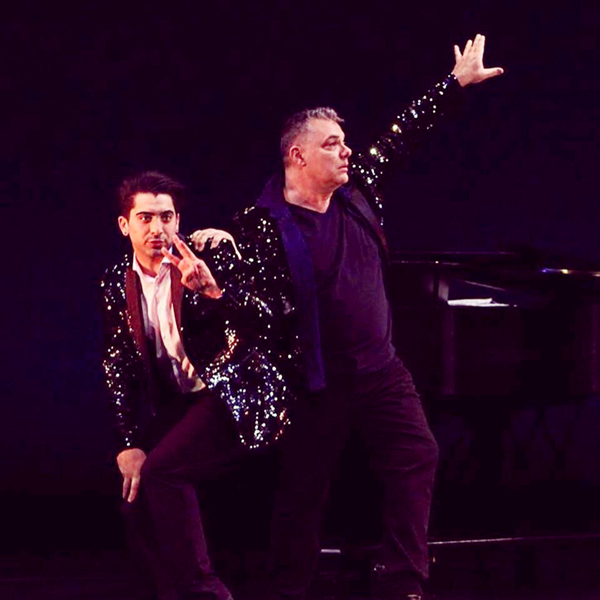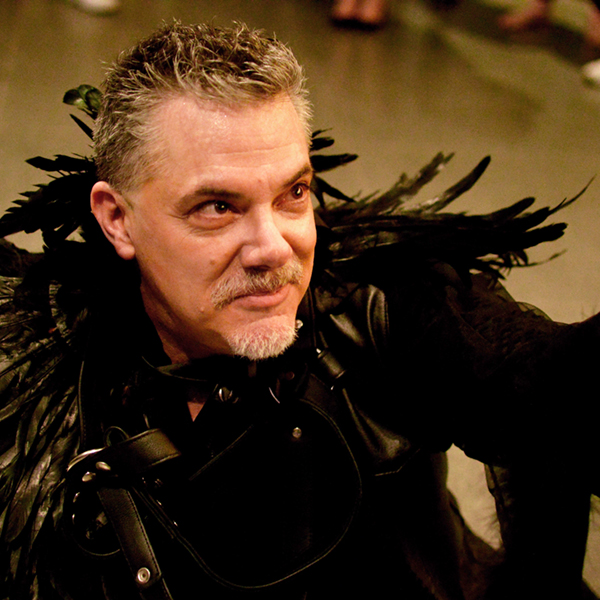On Making Good Art and Holding Hands Respectfully
An Interview with Peter DiMuro
BY EMMALY WIEDERHOLT
Peter DiMuro has worked as a dancer, actor, choreographer, director, teacher, arts engager and facilitator for more than 30 years. Currently based in Boston, he is artistic director of Public Displays of Motion, a creative umbrella for developing and performing artistic works in dance and dance/theater. He also serves as executive artistic director of The Dance Complex, a central dance hub in Boston. Here, he shares more about his most recent work, Significant Others: Dances for Family, Friends and Lovers, as well as how he utilizes his leadership roles to invite other voices into the conversation.
Photo by Olivia Moon Photography /@halfasianlens
~~
Can you share a little about your dance history – what kinds of performance practices and in what contexts shaped who you are today?
I’m 35 years into this, and I’ve reinvented myself every seven to eight years. Locally in Boston, I started making work at the height of the AIDS crisis. It was about bridging the gay and straight worlds, as I had just come out. Then I went to work with Liz Lerman for what I thought would be three years but ended up being 15. That was an amazing and pivotal time for me personally because I went from making solo identity work to helping facilitate the bridging of communities through engagement. I ended up running the company the last five to six years I was there because Liz had won a MacArthur that sent her on this new track – speaking more, a new project – so I ran the day-to-day operations. We toured all over the world, making and directing work on a healthy budget, mostly because of Liz’ name.
After I left, I took about three years to figure out who I was again after touring 30 weeks out of the year. I went to not touring and not having a budget, as well as trying to figure out who I am that’s different than Liz Lerman and the Dance Exchange. The past six years, I’ve realigned myself by running The Dance Complex in Central Square in Boston. It’s comprised of classes, studios and a performance series as well as services to the field. At the same time, I’ve been choreographing more, and I have a company that resembles the intergenerational aspect of Liz’s company. We’re doing a lot of site-specific work and seeing dance through a different lens. The newest arc of work in the past three months or so I’ve been making has been looking at what it means to be a gay man raised in a gay era, now immersed in a queer world.
Can you share a little about Public Displays of Motion and why you created the company?
I had an earlier company called Performance Associates. I wanted it to sound like a law firm because my brother is a lawyer and wasn’t very generous about my choice of career early on, so it was a little stab at the established world. When I left Liz’s company, the name “Public Displays of Motion” came first before there was a company. I always felt like the word “dance” sometimes demanded extra translation or explanation. Public Displays of Motion is truly about any human movement. It functions as an umbrella over my creative projects. The makeup of the current company is ages 17 to late 60s, and the dancers are committed to the human and humane inside dance. Even though we do structured dances on stages, we might also perform in a public park or around a dinner table. We flatten the hierarchy of performance.
How would you generally describe your work to someone unfamiliar with it?
The subject matter of the work is often things that are relatable to everyday people, not just a dance crowd. I feel my work is postmodern, but some postmodern work is most concerned with lots of abstractions. I want relatable gesture and iconic bits of language or song to give people a landing or a portal into what the dance is about so they can deal with the later abstractions as they come up. It’s pretty weird how, for audiences new to dance, we run around, lift each other up, and fall to the floor. But audiences clue into the visual, and one portal is who they see dancing; in addition to their age range, my dancers and those other artists and community members who join us are a wide range of people from different races, different genres of dance, different abilities, etc.
Photo by Olivia Moon Photography /@halfasianlens
Can you tell me about your most recent piece, Significant Others: Dances for Family, Friends and Lovers, and its guiding themes or concepts?
In the past few years, I kept writing grant applications saying I wanted to understand who I was before joining the Dance Exchange to understand who I am now. The first full-length evening I made in Boston when I was 28 or 29 was called Significant Others: Dances for Family, Friends and Lovers. My former lover at the time was dying of AIDS, and the work explored this but also explored love between family and friends.
Fast forward 30 years, I’m trying to understand my view from a historical lens of the current world. I re-used the title so as to create a basket to figure out which dances to add or make anew. I’ve included three of the older dances, which are based on family letters. The two new works are collaborations with younger men, one in his 20s, Alex Davis, and one in his 30s, Michael Winward. I wanted to find out what it means to collaborate with someone and not be the boss, and to make work from their queer sensibilities versus my gay sensibility. So the 30 year-old container of Significant Others was brought back and now there’s new inside the old.
What does your choreographic process look like, either more generally or specific to Significant Others: Dances for Family, Friends and Lovers?
That’s changed a lot. In the old days, I came into rehearsal with every step planned, though we might have improvised on partnering. Fast forward, a lot of the methods and tools I use are borrowed or adapted from The Dance Exchange, which really take postmodern collaborative methods from improvisation or devised theater. It’s a mix of that with my proclivity for giving assignments and prompts, interviewing dancers, and having people make movement on their own that then becomes phrases and eventually the vocabulary for that work. I feel like my job is rearranging the furniture with a director’s eye so the audience can recognize a structure. I see myself as a director or conceptualizer; I more often than not say that the choreography is by everybody in the performance. That’s also true of the composer of the sound score or music. Those people have a role in the crafting of things as well. It’s a relief not to think of my role as having all the answers all the time. The answers come through the dialogue of working together.
These two new collaborations with Alex and Michael are a step beyond that. It gets a little stumbly. Like dating, you want to be polite and congenial at first but, to get somewhere, you must ask harder questions or potentially disagree. It’s a new learning curve. When my name is on the company, people defer to that but, in these new works that might appear at my collaborator’s concerts as well as my own, then that’s out the door. It’s been good for me to articulate differently.
Peter DiMuro with Alexandrer Davis, Photo by JR Photography, courtesy of the Redfern Arts Center at Keene State College
Speaking more generally, are there certain themes or issues that feel important to you to keep tackling or addressing in your work?
Over an arc of 30 years, I’m back to the beginning looking at relationships. I come from a non-arts family. I grew up gay in the rural Midwest. My father was chief of police. I grew up in a traditionally macho world. I found that I could communicate better onstage, sometimes through movement and sometimes through movement and words. This was a key to communication not given to me as a kid. Not to compare my life with anybody who has been through more rigorous persecution, but I realized making movement and putting things onstage gave me power through communication. That’s been key throughout all the work I’ve done.
A friend, David Parker, has called my work, “Amiably subversive.” What I do is kind of renegade, like protesting. During the AIDS crisis, I couldn’t get out on the streets during ACT UP for whatever reason, but I could get onstage. It was my way of acting up and out. Those themes I’ve never really left, even when I get more traditional commissions. It’s not always overt, but it is its own subversion. I want to find ways to adjust the perspective or picture with whatever it is I do.
Another hat you wear is executive artistic director of The Dance Complex. From your perspective working both choreographically, directorially and administratively, how have you seen opportunities for and representation of voices that are often marginalized in the dance field (like LGBTQIA+, people with disabilities, people of color, immigrants, etc.) change during your career?
I’ve seen a lot of shifts, though I do still run into choreographers who aren’t dealing with those issues. But for anybody in research and development, it’s happening all around us. At The Dance Complex, we have an odd stew of very diverse faculty. We have teaching artists from all over the world. For example, we’ve offered seven different types of African dance from seven different African countries. When I arrived here after working with Liz, most of Boston was still catching up on issues of engagement and awareness compared to some of the work I’d seen around the country.
The community engagement that Liz or I were doing in the late 90s and early 2000s doesn’t fly anymore. We were pioneers in community engagement, but we had grown out of the preceding movement of outreach where people came in, taught kids how to dance, and patted their heads. Then we got to the engagement era, which was more about asking questions, dialoguing and interviewing. Still, the artist was in control; the artist was going to make a piece, and we made a pact with the communities we were in that we would shape it together. Fast forward to now, agency is the big difference. I cannot go into a community and say I want to collaborate with them, but I still get to tie the bow at the end. Sometimes it’s difficult for me as someone who has been previously marginalized to say, “Hey, really, I’m on the same team.” But in reality, it’s a good thing. I’m no longer necessarily the boss. Leading The Dance Complex like my journey with my two new collaborators. I may have some skill and be able to facilitate and be able to see the larger picture because of my experience and admitted privilege, but I find myself stepping back to the circle and bringing others in to facilitate our community. That’s been our latest thing at the Dance Complex is realizing I’m not the one to solve problems. Sometimes it’s my job to remove myself.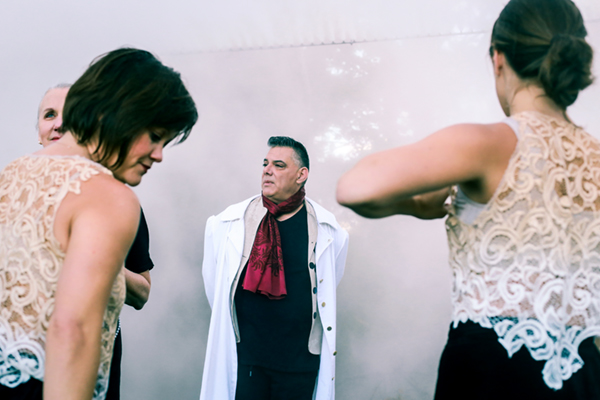
Photo by Olivia Moon Photography /@halfasianlens
It’s not easy; the conversations are so damn hard sometimes. For instance, there’s the question of what hip hop is and who gets to teach it. We’re finding ways to include more of the “other” under our roof, and our conversations are becoming more dimensional. We’ve been talking about hip hop and how it’s often geared toward the male figure displaying typical qualities of masculinity. In the queer community, there’s a movement toward empowering those with more feminine qualities to dance as strongly as those with male qualities and have them be equally well-received. So it’s not a black versus white issue or class only issue. It’s about gender and culture and evolving the form.
We’re at a place when we’re asking hard questions, acknowledging our lineages, and then going forward making dances and finding ways to sustain dialogue. The Dance Complex is about to publish online a document called Culture of Community that will replace our code of conduct. Insurance companies said we needed a code of conduct, so we scrambled to put together a code and got hit with, deservedly, a lot of pushback: “Why are you telling us how to act? Why do we have to do this?” We got to this place of, “How do we dialogue about this?” Throughout a year, we held a series of meetings. The result is this document that’s saying we want to be transparent about what we believe and work together on stating what our values are as a community. It will be available on Google Docs or some dynamic drive where people can add their thoughts or comments. We’ve acknowledged it is not perfect, but that it’s who we are as of this writing. We’ll review it periodically through meetings and open comments to ensure it continues to fit our values and that it also covers what we legally have to say. We can’t solve problems by mandating. We had to find a way to holistically have these conversations.
Any other thoughts?
With Public Displays of Motion, we have two artists with disabilities who are often part of the work. I mention this because I want to make a point about the world of universal design. There’s something so holistic about the way those working in the disabilities world are going about making it clear that universal design – ramps, adjusted sound levels and the tactile-ness of doorknobs, to name some examples – is good for everybody, not just those with disabilities. Similarly, I feel like my company is good for everybody, not just 20-somethings. If the world could get to this place of honoring past hurts and reparations, and then move beyond it, we can find a way for it to be good for everybody. That’s where I am personally, in my company, and with The Dance Complex. Reparations are equally important, but I want to see a time when we make good art and hold hands respectfully. That’s my goal for the next however many years I’m alive.
Photo by Victoria Awkward – VLA ARTS
~~
To learn more visit www.publicdisplaysofmotion.com or www.dancecomplex.org.

